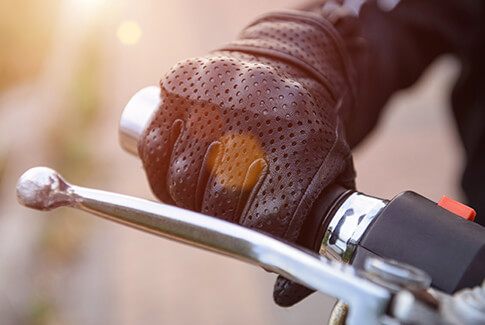6 ways to make the most of motorcycling season

Heading out on two wheels this summer? Here’s some advice to help you ride safely and make the most of your time on the open road.
The right questions to ask before buying a motorcycle
Thinking of buying your first motorcycle our getting a new one? The first thing to do is figure out your budget. A new bike can go for anywhere from $7,000 to $40,000. Of course, you can always get a used one for less. If you do find a used one you like, be sure to have it inspected before you buy. It’s also good to have some basic mechanical knowledge.
Next, decide what you want to do with your bike. That will determine the kind of model you want. For example, if you’re planning on travelling with a passenger, check to see how comfortable the rear seat is on the model you want. Like off-roading? You’ll want to look at adventure and dual sport bikes. You also need to think about the position you want to ride in. Different bike categories (custom, sports, road, dual sport, utility, dirt, etc.) have different rider positions. Some tilt you forward, while others have you in a normal seated position.
You should also consider the size of the bike. The bigger the machine, the harder it can be to steer. And the higher it is, the harder it will be to mount. Respect your abilities and limitations as a rider. It’s one of the best ways to stay safe. Taking bikes out from the dealer’s for a road test will also help you make a decision. With some dealers, you have to book road tests in advance. Find out before you go!
Riding your motorcycle and getting your license

If you have or plan to get a Class 6A, 6B, or 6C bike, you’ll need to get your motorcycle driver’s licence before you can legally take it out on the road. That involves passing a knowledge test, taking a course, and passing two road tests.
To get a licence for a three-wheel Class 6E motorcycle, you’ll need to hold a Class 5 licence and complete a one-day course.
If you already have your motorcycle licence but feel like you need to go over a few things, you can take the SAAQ motorcycle safety quiz to test your knowledge. Many driving schools also offer advanced rider training.
Registration and insurance
You have to pay each year, in April, to renew your motorcycle registration. The amount covers your SAAQ insurance, the registration fee, and a processing fee. The total amount can be anywhere from $298 to $2,022.01 depending on the cylinder size and the frequency of accidents for your type of bike.
In terms of insurance, all motorbike owners are legally required to hold at least $50,000 in civil liability insurance. Of course, you can always get more if you need it. Don’t hesitate to ask for advice about how much insurance you should have.
Roadside assistance in case something goes wrong
The average motorbike weighs about 400 lb. If you have a mechanical problem or your battery suddenly dies, the chances that you’ll be able to push it to the nearest garage are pretty slim. They’re even slimmer if you get a flat with a tire that has an inner tube. The best way to ride easy is to sign up for roadside assistance.
Clothing, protection, and gear

Pictures of people riding motorbikes in their t-shirts with the wind in their hair may have appeal, but what they depict isn’t safe. Or realistic. When you ride a motorbike, you’re legally required to wear a helmet with a visor that meets regulatory manufacturing standards. If you don’t have a visor, you’ll need to get protective goggles.
Wearing an armored jacket made of anti-abrasive material like Kevlar or Cordura, or leather, is also strongly recommended. Pants with the same features can also help keep you safe. And well-constructed gloves will help keep your hands warm on rides. To protect your feet and ankles properly, motorcycle boots are still the best option. If you want to wear something else, avoid steel-toe boots.
If you ride your bike from April through to October, there are gadgets like heated gloves and handles for cold days and cooling shirts you can wear under your jacket on hot summer days. If you plan to go on motorcycle trips, there are plenty of options for adding saddlebags to your bike so you can pack your things.
Maintenance and storage
If you’ve got all your gear, meet the legal requirements to ride, and are ready to go, there are just a few things left to check:
- Your battery, since motorcycle batteries are generally small, not very powerful, and lose their charge easily, so it may be low or dead after spending the winter in the garage
- Fluid levels (brake and cooling, and motor oil) to make sure you’re not running on empty
- Your brakes and tires to make sure both are in good shape
Remember to change your oil at least once a year, before putting it away for the winter, and make sure the drive chain is properly lubricated. Check the air pressure in your tires regularly, especially at the beginning of the season.
For all your maintenance needs, or to have a used bike inspected before you buy it, don’t hesitate to take your bike to a CAA-Quebec Approved Auto Repair Service Location that specializes in motorcycles.
Always keep in mind that the only thing between you and the road is a hunk of metal on two wheels.
After a great season spent riding your bike, be sure to store it out of the elements. Finally, don’t forget to notify SAAQ (Société de l’assurance automobile du Québec) once you’ve stored your bike for the winter.

Benefit from personalized advice
Do you have questions about gas-powered or electric vehicles, driving, or need recommendations to find an Approved Auto Repair Service?